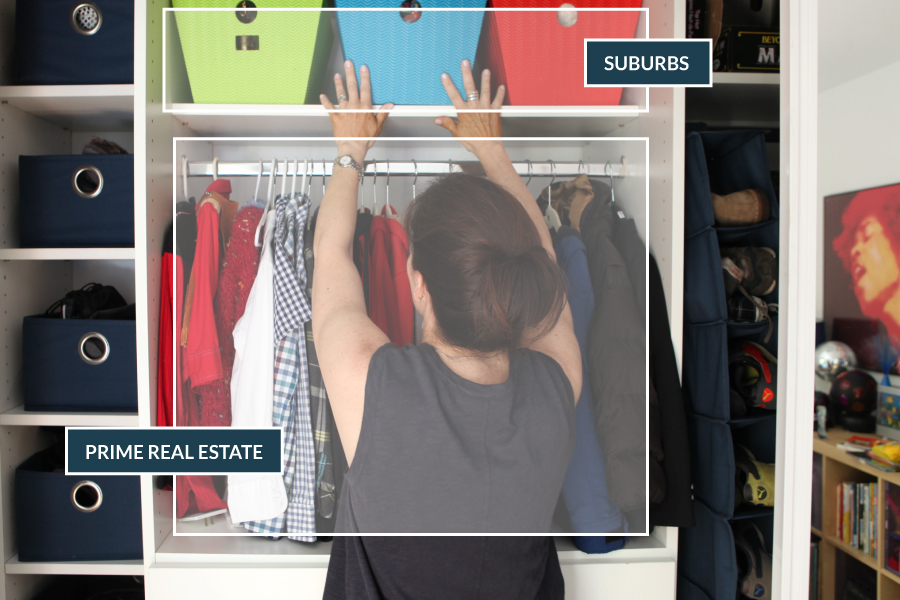One of the second tenets of organization (following the first, which I wrote about here) is the location of the “homes” you create for your possessions. No organizing product, system or magic trick has greater impact on keeping your space organized than where you decide to keep the items you need to run your home, office or life. I call this “Prime Real Estate:” your most used possessions are entitled to that beachfront home in Malibu, while less used, seasonal or archival possessions are relegated to the ‘burbs.
Kitchen
To illustrate this point, let’s start with the kitchen: store your pots, pans and baking sheets closest to the stove and oven. Cooking utensils should either go on the countertop or in a drawer near the stovetop, while spices should be accessible to the stove and food prep area. Lesser used baking items (unless you’re a master cookie chef and bake all the time!) such as a mixer, mixing bowls, muffin tins and cookie cutters can be stored farther away from the stove in cabinets out of heavy traffic areas. Likewise, daily dishes and silverware should go in the most accessible cabinets (near dishwasher for easy unloading is optimal!) while china, trays and serving dishes typically used for entertaining or special occasions can be stored farther away.
To take this one step further, establish zones within zones: put your most used pots and pans in the front of the cabinet where they are most accessible; place your most used spices on a shelf where you can easily reach them, and put lesser used spices on the shelf above.
Closet
The same theory works with clothes: hang your most worn threads in the front of your closet and relegate lesser-worn garments to the back. So as you tuck dressy gowns or evening attire into the more inaccessible corners of your closet, let your favorite faded jeans and beloved lived-in tees take center stage.
If your closet is small, you may need to rotate your clothes by season and frequency of use: store off-season clothes on upper shelves or rods, and move current season clothes to lower shelves and rods. Sandals step forward in the spring and summer, while boots come out in the fall and winter.
Office
Paper lives and breathes by where it resides: active files such as bills to pay, pending projects or reference documents that are consulted frequently should be kept in file drawers, desktop file holders or wall pockets that are easy to access and review on a daily basis. Utility, credit card and bank statements (if you haven’t gone paperless yet – stay tuned for a future post!), mortgage payments and medical files can be kept in less accessible locations like a lower drawer or file cabinet in another room, while tax returns and archival paperwork can be sent into hibernation in an even more distant location, only to come out when/if needed or when it’s time to retire and shred the documents.
Planning your Location Landscape
To set this system up in your own home or work space, begin by reviewing your possessions and identifying what kind of residence they should take up in your home:
PRIME REAL ESTATE
Resident: items used daily or which are essential to operation of home or office
Location: front of cabinets, top drawers, accessible shelves, proximity to activity
SUBURBS
Resident: holiday decor, seasonal sporting goods, archived memorabilia
Location: upper shelves of closets, lower drawers, attics, basements, garages
[av_hr class=’default’ height=’50’ shadow=’no-shadow’ position=’center’ custom_border=’av-border-thin’ custom_width=’50px’ custom_border_color=” custom_margin_top=’30px’ custom_margin_bottom=’30px’ icon_select=’yes’ custom_icon_color=” icon=’ue808′ font=’entypo-fontello’ av_uid=’av-fq1nz’]
What heavily used items do you currently have stored in inconvenient places? Which items could you promote to prime real estate status and what could you move out to the suburbs? Please leave your feedback in the comments below!
[av_hr class=’default’ height=’50’ shadow=’no-shadow’ position=’center’ custom_border=’av-border-thin’ custom_width=’50px’ custom_border_color=” custom_margin_top=’30px’ custom_margin_bottom=’30px’ icon_select=’yes’ custom_icon_color=” icon=’ue808′ font=’entypo-fontello’ av_uid=’av-98qqv’]

Having worked in retail, clothing in particular, for years when I was younger, the concept of color coding by sleeve length, and type of item, was embedded into my “idea” of how a closet should be organized. Do you think I should be focusing more on what I wear the most versus color/item/sleeve length? Maybe what’s most used followed by color? Would also love to hear your tips on purging unused items from the closet; an ongoing problem in my mine!!
Thanks for your great questions, Kim! Sounds like you have a good handle on organizing clothes. By all means, continue organizing your closet by color, but what’s more important is that you hang the categories you wear most in the most accessible location — like front and center. For example, if you hardly wear dresses but almost always wear pants and blouses, hang your dresses on one end of the closet and hang your pants and blouses in the center (or however you reach into your closet) so you can see, touch and review those items first. As for purging, I like to ask my clients the following questions: 1) Does it fit? 2) Is it free of holes, stains or other damage that is not easily mendable? 3) Have you worn it in a year? (I make exceptions for specialty items like evening wear) 4) Does this match your current lifestyle? and 5) Does it make you feel fabulous? If you answer “no” to any of those questions, it’s time to let it go. Happy purging, Kim!
Oh, but surely I’ll be back in those size 2s and 4s someday, won’t I? Amazing how hope never dies, even though the body is going down with gravity! Goodwill, here I come!
Does looking at all those size 2s and 4s make you sad? Then out they go! It’s not about what you’re letting go of, it’s about what you keep. And I’m fairly sure you have some pretty fabulous size 6s in your closet!